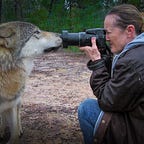Peyote Bird
The Beauty and Magic of the Sacred Anhinga (Anhinga anhinga)
It is said that Leonard Crow Dog called the Anhinga the greatest symbol of the Native American Church. And if you’ve had the privilege of viewing any NAC artwork, you’ve no doubt seen the bird represented in vivid color illustrating an obvious prominence in belief and ceremony.
The Anhinga is intriguing to me, not only because I had been gifted some of this art in years past, but because I encounter the bird consistently during my hiking and kayaking excursions throughout Florida. Because of its deep black coloration, striking orange banded tail, and often outstretched wings, it can typically be spotted at a great distance.
Also interesting, are the many names this species has been given from around the world. The Creole of South Louisiana call it “Bec a Lancette”, while the common name is Brazilian Tupi for “snake or devil bird.” These are likely descriptions of morphology — the lance like beak and the red eyes of the mating male, that when reviewing my first Anhinga portraits caused me to wonder if I’d made a technical error with my camera. Additional names include the “water turkey”, the “Grecian Lady” and “the Jesus bird”.
Many a bend in a river have I come around to see an Anhinga, wings outstretched like a beacon, guiding my way, urging me forward, whispering to me “You’re going the right way.” It’s a rather awe-inspiring sight — one of those moments that you can’t articulate because words seem inadequate to capture the sacred.
Apparently I’m not the only person to feel this way, as is demonstrated in the artwork displayed below. As the quintessential “water bird”, it is a symbol of life, a messenger, and very important in ceremonial healing practices.
The overarching theory regarding the explanation for the oft-seen outstretched wings, is that the Anhinga does not possess oil producing glands as efficient as those of other birds and therefore experiences a more difficult time water-proofing the feathers, as opposed to waterfowl — like a duck — where water “rolls off the back.” So the Anhinga is suspected to be drying the wings in cruciform display.
However, an alternative theory suggests that they do indeed have efficient oil glands, but are utilizing the classic posture for thermoregulation. They have bones that are more dense than other birds, and are by constitution less buoyant; the upside of this is that they can dive to deeper depths than other birds, and can swim along under the water scanning for food for extended periods.
Anhingas are related to pelicans and cormorants, but like a vulture they can fly long distances without having to move their wings. In other words, they can soar quite well.
It is this black water bird that prompted some of my growth as a photographer, because even though the wings are outstretched and still, I often find them exhibiting a lot of facial movement, and side to side head turning and bobbing. It took a bit of shutter speed experimentation to actually capture the appearance of a still image with this particular bird. This is in contrast to other species, which I’ve long easily photographed without making any settings adjustments on my camera.
As a bird of the swamp, and a bird important to Native American brothers and sisters, the Anhinga has become increasingly special to me, greeting me at so many turns, accompanying me in my travels, whispering softly to me that I am still going the right way. And I plan to keep listening…
My series of Anhinga shots may be viewed on the following sites and is dedicated to my sister, Rochellda, on the Alabama-Coushatta Reservation in Texas. Ro, may you have peace and healing.
eliewolf7.500px.com | @eliewolfphotography | @artofeliewolf
